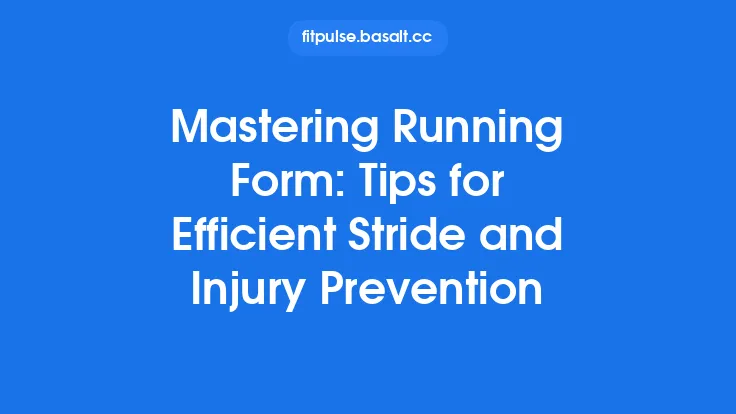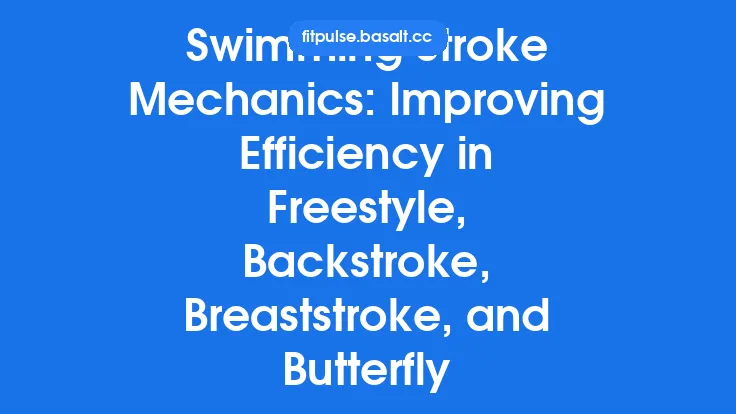Backstroke is the only competitive swimming stroke performed on the back, which gives it a unique set of biomechanical demands. Mastering the backstroke means developing a harmonious blend of body alignment, efficient arm and leg mechanics, subtle rotation, and precise timing. When these elements click together, the swimmer can glide through the water with minimal drag while generating powerful propulsion, ultimately translating into faster race times. Below is a comprehensive guide that breaks down each component of the stroke, offers practical drills, and outlines training strategies to help swimmers of all levels refine their form and boost speed.
Body Position and Alignment
Why it matters
A streamlined body position reduces frontal resistance and allows the propulsive forces generated by the arms and legs to be transferred directly into forward motion. Even a slight deviation from the optimal line can increase drag dramatically.
Key elements
| Element | Description | Tips for Consistency |
|---|---|---|
| Head | Keep the head still, eyes looking straight up toward the ceiling. The waterline should be just above the hairline; the face remains relaxed, with the mouth slightly open for natural breathing. | Use a mirror or video to confirm that the head does not lift or dip during the stroke cycle. |
| Neck | Maintain a neutral cervical spine; avoid excessive extension or flexion. | Imagine a thin string pulling the crown of the head toward the ceiling. |
| Shoulders | Shoulders should be level and relaxed, with the shoulder blades gently drawn together (scapular retraction) to create a stable platform for the arm pull. | Perform “scapular squeezes” on land: pull shoulder blades together and hold for 3 seconds, then release. |
| Hips and Legs | The hips should sit high in the water, creating a slight “V” shape with the legs. The knees are slightly flexed, but not so much that they create a “frog” kick. | Practice “hip lift” drills: while holding a kickboard, focus on keeping the hips near the surface. |
| Core | A strong, engaged core maintains the straight line from head to toe and prevents excessive rolling. | Incorporate plank variations and hollow-body holds into dry‑land sessions. |
Common alignment errors
- Head bobbing: Often caused by over‑breathing or a lack of core stability.
- Hip drop: Leads to increased drag and a weaker kick.
- Shoulder roll: Excessive rotation can disrupt the arm pull path.
Arm Pull Mechanics
The arm pull is the primary source of propulsion in backstroke. It consists of three distinct phases: entry, catch, and pull‑through.
1. Entry
- Position: Hand enters the water thumb‑first, fingertips pointing slightly outward (about 30°). The entry point should be directly above the shoulder, not too far forward or backward.
- Depth: Aim for a shallow entry (hand just below the surface) to minimize splash and maintain a streamlined line.
2. Catch
- Elbow height: As the hand moves forward, the elbow should rise to a height roughly at the water surface, creating a “high elbow” position. This maximizes the surface area of the forearm and hand during the catch.
- Forearm angle: The forearm should be nearly vertical, with the palm facing outward, ready to “grab” the water.
3. Pull‑through
- Path: The hand follows an S‑shaped trajectory: outward, then inward toward the hip, and finally finishing near the thigh. This path maximizes the distance over which force is applied.
- Finish: The hand exits the water near the thigh, thumb first, ready for the recovery phase.
Drills to reinforce arm mechanics
| Drill | Focus | Execution |
|---|---|---|
| Single‑Arm Backstroke | Isolates each arm’s pull, emphasizes high elbow. | Swim with one arm at a time while the other remains at the side. Keep the non‑working arm relaxed. |
| Sculling | Enhances feel for water pressure and improves catch. | With arms extended forward, move hands in a figure‑8 pattern, maintaining a slight bend in the elbows. |
| S‑Pull | Reinforces the optimal S‑shaped pull path. | Use a pull buoy and concentrate on drawing the hand outward then inward, visualizing the “S”. |
Leg Kick Optimization
The backstroke kick is a continuous, alternating flutter that contributes both propulsion and body balance. While the arms generate the majority of forward thrust, an efficient kick can shave precious tenths of a second off a race.
Biomechanics of the kick
- Amplitude: The kick should have a moderate amplitude—large enough to generate thrust but small enough to avoid excessive drag.
- Frequency: A higher kick rate can increase speed, but only if the swimmer can maintain it without compromising arm pull timing.
- Ankle flexibility: A relaxed, plantar‑flexed ankle (toes pointed) reduces resistance and improves the “whip‑like” action of the kick.
Key cues
- Hip‑driven motion – Initiate the kick from the hips, not the knees. Think of the legs as a pendulum swinging from the hip joint.
- Straight but relaxed knees – Keep the knees straight, with a slight, natural flex during the downbeat.
- Narrow kick – The feet should stay close to the body’s midline, minimizing lateral drag.
Kick‑specific drills
| Drill | Objective | How to Perform |
|---|---|---|
| Vertical Kick | Builds ankle flexibility and leg strength. | In deep water, maintain a vertical position and kick rapidly without using the arms. |
| Kick with Board (Hip‑High) | Encourages hip‑driven kicking. | Hold a kickboard at the chest, keep hips high, and focus on generating kick from the hips. |
| One‑Leg Backstroke Kick | Improves balance and isolates each leg’s contribution. | Alternate kicking with only one leg while the other remains still, switching sides each length. |
Body Rotation and Streamlining
Unlike freestyle, backstroke rotation is subtler but still essential for a powerful pull and efficient breathing.
Rotation mechanics
- Degree of roll: Typically 30–45° of roll from the vertical axis, synchronized with the arm pull. The shoulder of the pulling arm drops slightly while the opposite shoulder rises.
- Timing: Rotation should begin as the hand enters the water and peak as the hand reaches the catch phase. The body then returns to a neutral position during the recovery.
Benefits of proper rotation
- Longer reach – Allows the pulling arm to enter the water further forward.
- Reduced shoulder strain – Distributes forces across a larger range of motion.
- Enhanced kick efficiency – A slight roll opens the hips, enabling a more powerful kick.
Drills for rotation
| Drill | Description |
|---|---|
| Double‑Arm Rotation | Swim backstroke with both arms moving simultaneously, emphasizing a smooth roll of the hips and shoulders. |
| Side‑Kick with Rotation | While holding a kickboard on one side, rotate the body gently from side to side, feeling the hip movement. |
| Superman Pull | Extend both arms forward, pull one arm at a time while allowing the body to roll naturally, then switch. |
Breathing Technique
Because the face remains above water, backstroke breathing is often taken for granted. However, efficient breathing still influences body position and timing.
Optimal breathing pattern
- Continuous, relaxed breathing – Inhale through the mouth as the head naturally lifts slightly during the arm recovery, and exhale through the nose or mouth while the face is submerged.
- Synchronize with the pull – Begin inhalation as the opposite arm finishes its pull and the recovering arm lifts, ensuring no interruption to the stroke rhythm.
Tips to avoid common pitfalls
- Avoid excessive head lift – Raising the head too high creates drag and disrupts alignment. Keep the chin just above the waterline.
- Maintain a steady exhalation – A continuous exhalation prevents a buildup of carbon dioxide and helps keep the torso relaxed.
Breathing drill
- “3‑2‑3” Rhythm – Swim three strokes, take a quick, controlled breath on the fourth stroke, then resume a three‑stroke rhythm. This reinforces timing and prevents over‑breathing.
Start and Finish Fundamentals
While detailed turn mechanics belong to a separate topic, the start and finish are integral to overall backstroke speed.
Backstroke Start
- Set‑up – Position the feet shoulder‑width apart, toes on the wall, hands gripping the start bar. The head should be in line with the spine, eyes looking upward.
- Launch – Push explosively off the wall, extending the hips and shoulders simultaneously. The body should follow a streamlined, slightly arched trajectory.
- Entry – Enter the water with a tight, streamlined position; the arms extend forward, and the head remains neutral.
Finish
- Timing – The final stroke should be timed so that the swimmer’s hand touches the wall just as the hip passes the vertical line of the wall. Over‑stretching can cause a loss of momentum.
- Body position – Keep the body flat and streamlined; a slight upward tilt of the head can help gauge the wall distance without breaking form.
Start/Finish drill
- “Block to Wall” – Practice the entire start sequence from the block to a timed finish, focusing on a smooth transition from the push to the first stroke and a clean, powerful final touch.
Drills for Skill Development
A well‑rounded drill set reinforces each component of the backstroke while preventing monotony.
| Drill Set | Focus Areas | Sample Set (meters) |
|---|---|---|
| Technical Warm‑up | Body alignment, head position | 4 × 50 m (easy) – concentrate on a neutral head and high hips |
| Arm Isolation | High elbow, S‑pull | 6 × 25 m single‑arm (alternating) |
| Kick Emphasis | Hip‑driven kick, ankle flexibility | 4 × 50 m kick with board (focus on small amplitude) |
| Rotation Integration | Coordinated roll with pull | 4 × 75 m – “double‑arm rotation” |
| Speed Set | Maintaining form at race pace | 8 × 25 m backstroke sprint, 15 s rest, full stroke |
| Cool‑down | Recovery, technique review | 200 m easy backstroke, light focus on smooth breathing |
Progressive Training Strategies
To translate technical improvements into race‑day speed, swimmers should follow a structured progression that gradually increases intensity while preserving form.
- Foundation Phase (Weeks 1‑4)
- Emphasize technique drills at low intensity.
- Include 2–3 sessions per week focused on body position, arm pull, and kick drills.
- Use video feedback after each session to identify alignment issues.
- Build Phase (Weeks 5‑8)
- Introduce moderate‑intensity interval sets (e.g., 10 × 100 m at 80 % race pace, 20 s rest).
- Maintain a “technique block” at the start of each workout (e.g., 4 × 50 m drill).
- Begin incorporating race‑pace starts and finishes.
- Peak Phase (Weeks 9‑12)
- Shift to high‑intensity, race‑specific sets (e.g., 6 × 200 m backstroke at goal race pace, 30 s rest).
- Reduce overall volume by 20 % while keeping intensity high.
- Perform full‑distance time trials to gauge progress.
- Taper (Final 1‑2 weeks)
- Decrease volume dramatically (40‑60 % reduction) while maintaining short, sharp efforts.
- Focus on mental rehearsal of the start, turn, and finish.
- Ensure adequate rest and recovery to arrive at competition fresh.
Video Analysis and Feedback Loop
Modern coaching often relies on video to pinpoint subtle flaws that are invisible in real time.
Steps for effective video analysis
- Capture multiple angles – Side view for body alignment, overhead view for arm path, and underwater view for hand entry and kick.
- Use slow‑motion playback – Identify the exact moment of hand entry, elbow height, and hip roll.
- Create a checklist – Compare each frame against the key cues outlined above (head position, high elbow, hip‑driven kick, etc.).
- Set specific goals – For example, “maintain a neutral head for 20 m straight” or “increase kick frequency by 5 strokes per minute.”
- Re‑record after 2‑3 weeks – Track improvements and adjust the training focus accordingly.
Common Mistakes and Corrections
| Mistake | Effect on Performance | Correction |
|---|---|---|
| Excessive head lift | Increases drag, disrupts body line. | Practice “head‑still” drills; keep chin just above water. |
| Low elbow during catch | Reduces propulsive surface area. | Use “high‑elbow” cue: imagine holding a water‑filled balloon under the forearm. |
| Knees bending too much | Creates a “frog” kick, increasing drag. | Perform “straight‑leg kick” drills with a pull buoy. |
| Over‑rotation | Leads to loss of balance and slower kick. | Use a snorkel to feel the correct roll; aim for 30‑45° only. |
| Irregular breathing pattern | Breaks rhythm, causes fatigue. | Incorporate “3‑2‑3” breathing drill to develop a steady cadence. |
Putting It All Together: Building Speed
Speed in backstroke is the product of three interlocking pillars:
- Hydrodynamics – Achieved through optimal body alignment, minimal drag, and a tight streamline.
- Propulsion – Generated by a high‑elbow, S‑shaped arm pull and a hip‑driven, high‑frequency kick.
- Timing – Coordinated rotation, breathing, and stroke rhythm that allow each component to work without interference.
A practical “speed checklist” for each training session:
- Pre‑set: 2 × 25 m easy, focus on head position.
- Main set: 8 × 50 m backstroke at race pace, each with a 5‑second “technique pause” after the third stroke to self‑assess alignment.
- Cool‑down: 200 m easy, visualizing a smooth, continuous glide.
By consistently applying the technical cues, integrating targeted drills, and following a progressive training plan, swimmers can transform a competent backstroke into a fast, efficient, and race‑winning stroke. The journey from good to great lies in the details—small adjustments made repeatedly over time yield the biggest gains in speed.





